The 8 best UCaaS providers of 2023 for businesses, ranked

Senior Product Marketing Manager, UCaaS

Tags
Share
Most of the time it’s nice to be spoiled for choice, but this isn’t always the case. If you’re trying to pick a unified communications solution for your business, it can be difficult to see the wood for the trees with the number of options out there.
The UCaaS market is booming right now and, of course, every provider thinks their product is the best. You want the unified communications solution that best meets the needs of your company, but where do you start?
Join us as we examine and compare some of the best UCaaS providers to help you make the right choice.
What is unified communications?
A unified communications platform (sometimes also called UC) refers to software that integrates multiple communication channels in a software tool or app. These channels include voice, video, and messaging mainly—but can also include other things like voicemail and file sharing.
The first generation of unified communications solutions required on-premises hardware to deliver these communications functions.
What is UCaaS?
According to Gartner, Unified Communications as a Service (UCaaS) is “a cloud-delivered unified communications model that supports six communications functions."
These functions are enterprise telephony, meetings (audio, video, and web conferencing), unified messaging, instant messaging, mobility, and communications-enabled business processes.
The "as a Service" element of the name refers to the typical pricing models, which are monthly or annual subscriptions. This makes UCaaS more affordable for startups or small businesses to avoid huge upfront costs for their business communications solution.
UCaaS vs. traditional unified communications
Unlike traditional unified communications providers, UCaaS solutions are deployed in a virtual cloud environment. This means that businesses no longer need to pay for and rely on a co-located physical infrastructure. Instead, the UCaaS service provider manages all the data and processing. We explore this in more detail in our VoIP vs PBX blog.
In addition to all the same functions as on-premises UC solutions (like telephony, audio and video conferencing, and instant messaging), UCaaS comes with features like screen sharing, real-time transcriptions, and contact centre software (either as a separate solution or an integrated part of the UCaaS platform).
Another benefit of UCaaS is that it can be accessed from anywhere on any Internet-connected device. For example, Dialpad is a UCaaS platform that has a desktop and mobile app (sometimes called a softphone app) that lets you make calls, text, and start video meetings in one place:
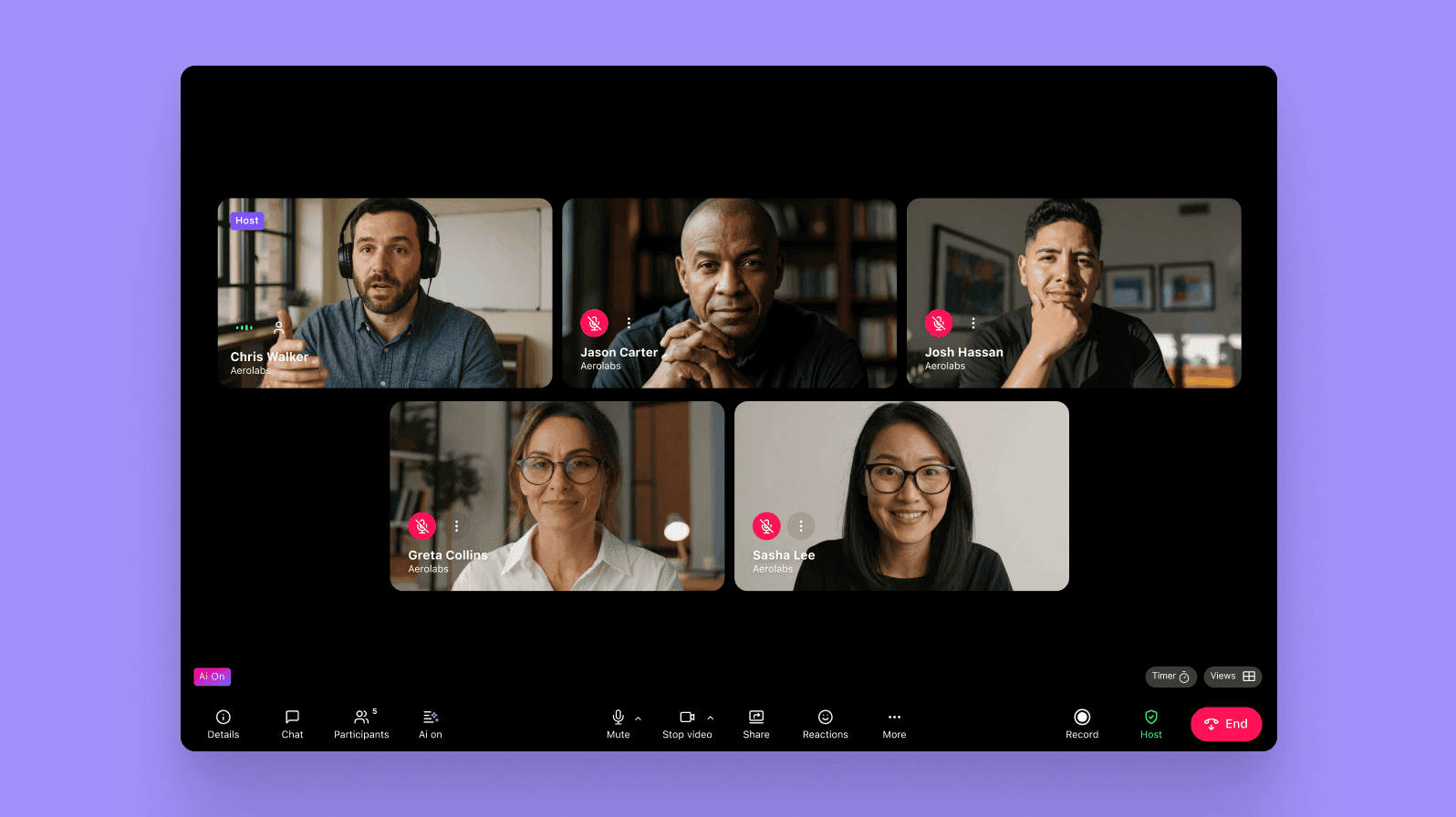
👉 Fun fact:
There are a lot of providers that used to offer only telephony or used to be on-premises services but have tried to evolve into UCaaS platforms. Often, their technology hasn’t quite caught up with their reputation. Make sure to do your research before selecting a UCaaS provider.
The differences between “UCaaS” and “VoIP”
Voice over Internet Protocol (VoIP) and UCaaS are often mentioned together, and there are some key differences between the two.
Think of VoIP as a telephony technology or function within a UCaaS solution that facilitates voice communications over the Internet.
In most cases, if you're using a UCaaS solution that lets you make phone calls over the Internet, it contains VoIP technology. That includes features beyond just making phone calls—like call routing, voicemail, and so on).
Here’s a closer look at some of the key differences and similarities between VoIP services and UCaaS in various different areas.
What to look for in a UCaaS platform
Fully integrated communication channels
This is the biggest thing: you should be able to communicate through different channels in your UCaaS platform—in one place, without toggling back and forth between separate apps or windows. For most organisations, these are the three main channels to consider:
Voice calling
A UCaaS system should enable you to make high call quality voice calls from any IP phone, desktop, or mobile device.
The thing to look for here is pricing. Some UCaaS providers will charge you by the minute for outgoing calls, while others will give you unlimited inbound and outbound calling. What makes it tricky, of course, is that the ones that charge you by the minute will probably have a seemingly cheaper plan—always read the fine print.
👉 Did you know?
Dialpad gives you unlimited outbound and inbound calls within Australia, the US, and Canada, even on its most basic plan.
Instant and SMS messaging
If you want to be able to message your teammates internally and clients or prospects externally, then look for a UCaaS solution that gives you both of those options. (Not all of them do!)
Some phone services provide SMS messaging alone, at a relatively low price, but that's pretty limiting and doesn't let you do other things like video conferencing.
Video meetings
Speaking of which... Video meetings are the third "essential" UCaaS functionality to look out for. Whether you want one-to-one web conferencing with clients or to get your remote team together for a conference, video capability is a must for most businesses.
The key feature to look for with video conferencing is the ability for someone to join your meeting without downloading the app. This is especially important if you have regular video meetings with clients or prospects, because they may not always be comfortable downloading anything.
For example, with Dialpad, anyone can join a video meeting on their web browser by clicking a link—no downloads needed:
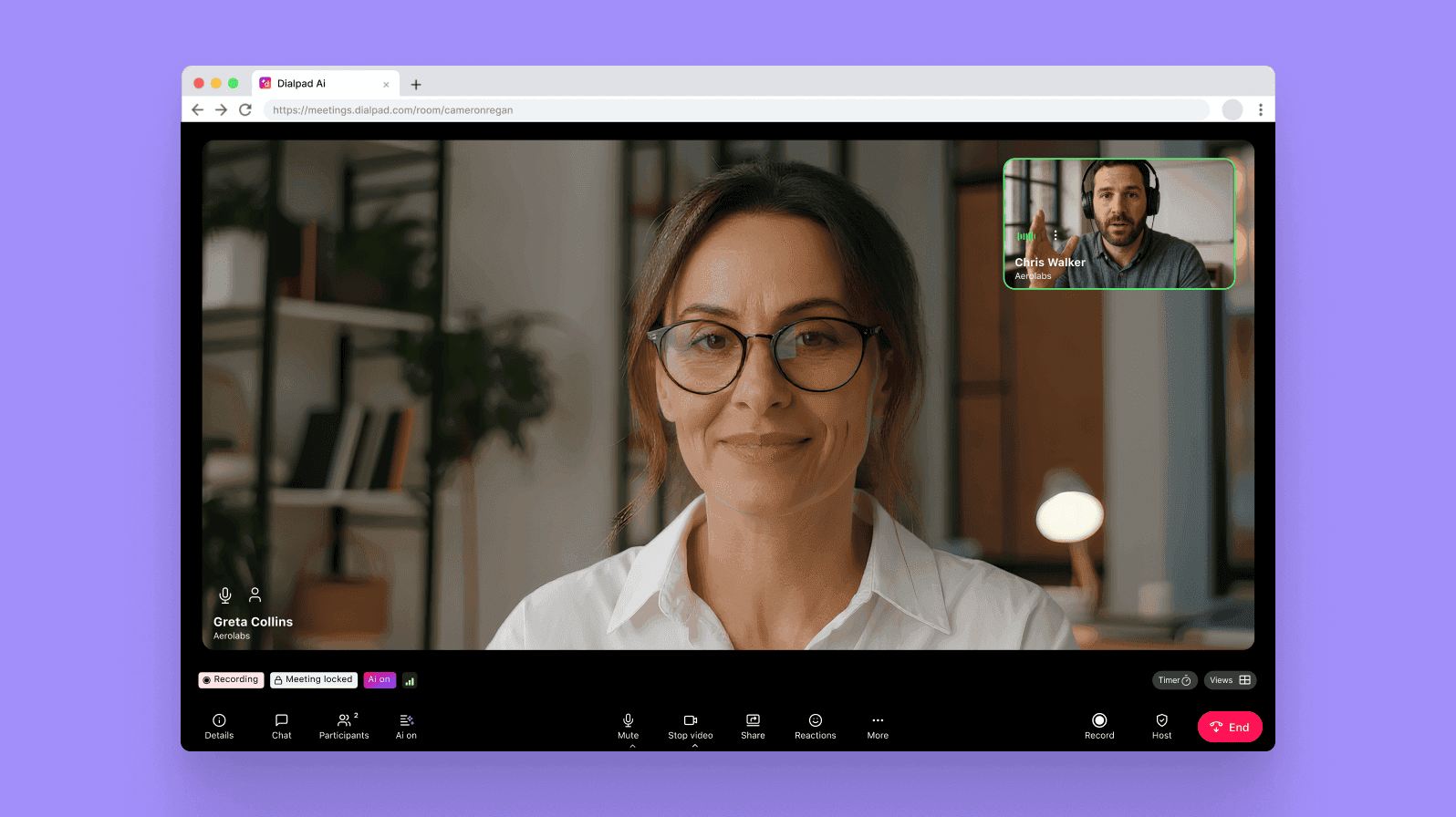
On a related note, screen sharing is also important, especially if you need to review designs or visuals with your team or with clients. With Dialpad, you can begin screen sharing with just a click—and you even start a screen share with clients by sending them an SMS with a link. Again, no need to download anything. (Our sales team loves this feature.)
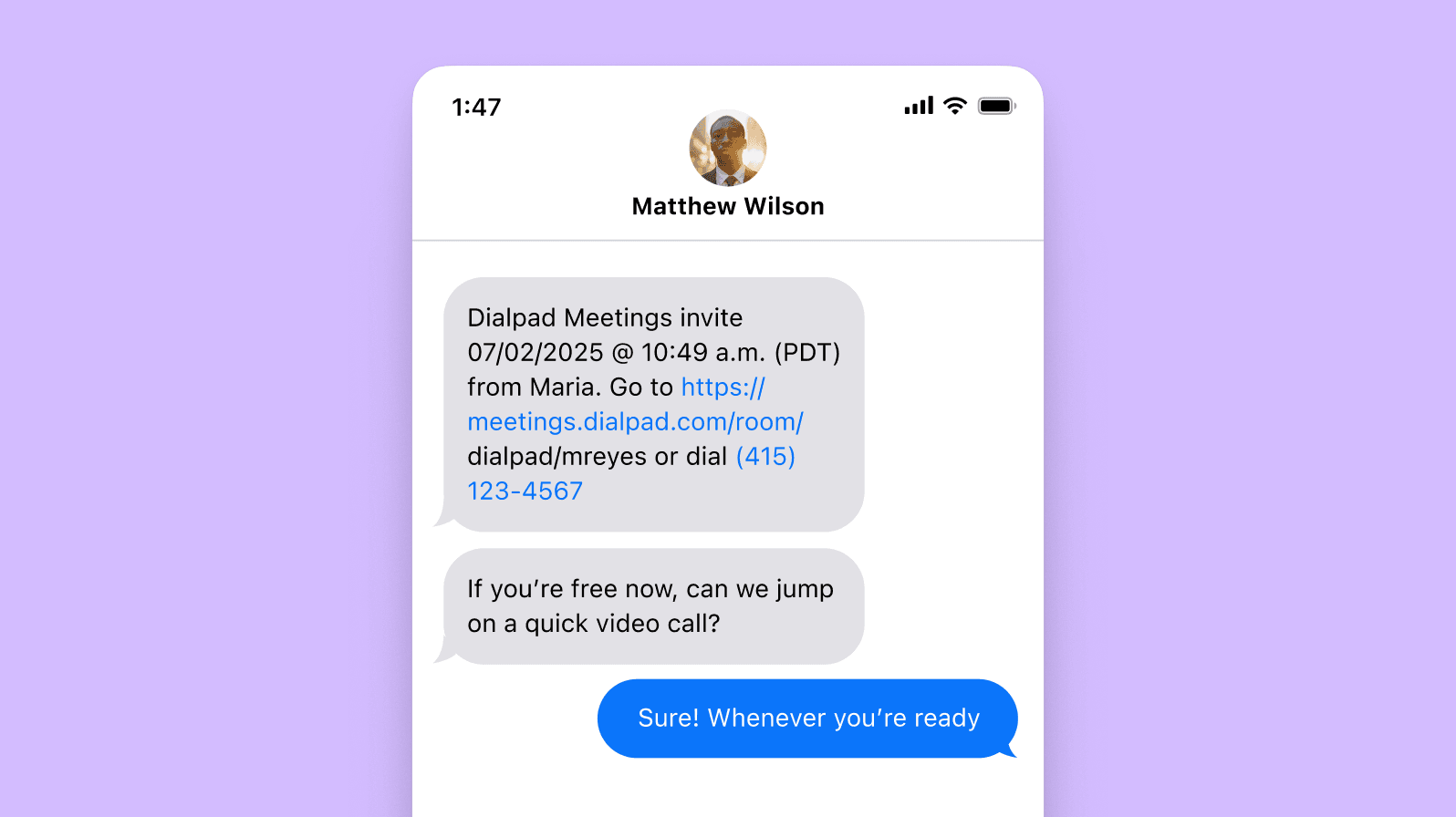
Voicemail
Voicemail is a commonly overlooked feature, but it's important because it allows your callers to leave a message when their call isn’t answered. Some UCaaS providers may charge for voicemail or voicemail storage, so look out for that one in the pricing.
Dialpad comes with voicemail and custom voicemail greetings even on the most basic plan, and, unlike a traditional hosted phone system, also has visual voicemail. This feature transcribes your voicemails so that you can read them and get caught up instead of having to listen to each one—which comes in handy if you're in lots of meetings and don't always have time to listen to voicemails:

Call routing
If you or your business gets lots of calls, then call routing is useful to have. This feature places calls in a queue before routing them to the appropriate agent or department. Dialpad has easily customisable call routing options to help you make sure every call goes to the right person:
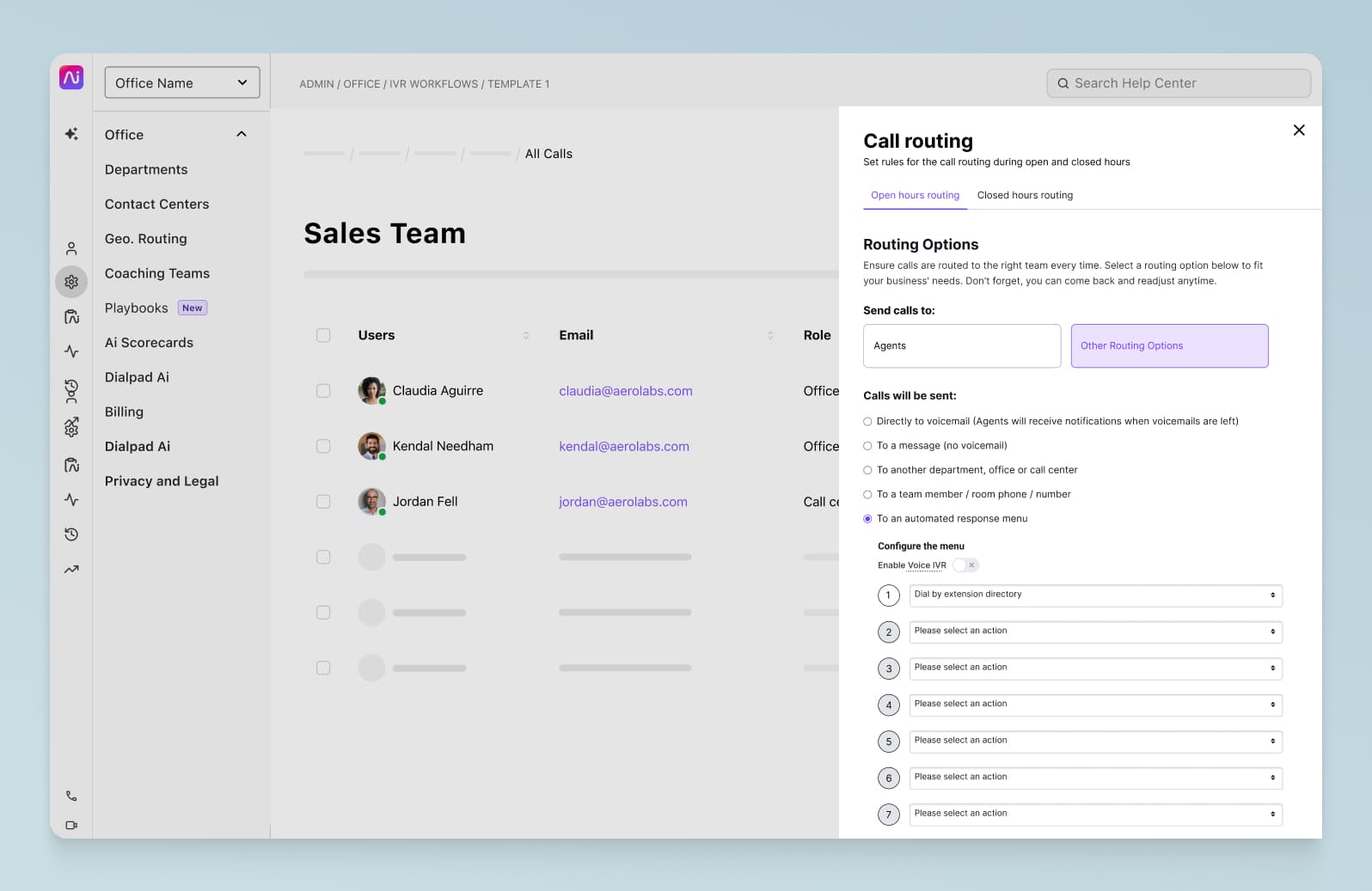
Time to implement
This isn't a feature, but any UCaaS solution (or VoIP business phone system) should be able to be easily implemented, without taking too much time.
Of course, every case is different, and getting a 50-person company set up is going to take a different amount of time than a 10,000-person company, but for most businesses, getting started should be as simple as signing up for a monthly or annual plan, downloading the softphone app onto your computer or mobile device, and starting to make calls.
Cost
This is a significant consideration for most businesses. My best tip here is to always, always check the fine print. Most UCaaS systems follow a very similar pricing model: you can pay month-to-month or annually. The annual option will almost always be anywhere from 5 to 15% cheaper—because of course, companies would like the security of having an annual subscriber as opposed to someone who can just leave after a month or two.
In addition to the price tag for each plan, look closely at what comes included in each tier. Many UCaaS providers will try and squeeze more money out of you for every little feature—anything from real-time transcriptions to voicemail to three-way calling, and more. (Dialpad's lowest tier comes with all three included at no extra charge.)
Maintenance and troubleshooting
With both VoIP and UCaaS solutions, maintenance and patching should be the responsibility of the service provider, and updates should be free and carried out automatically.
Here, you'll want to look at what kind of customer support you'll get at each pricing tier. Typically, the lowest tier will come with a more limited level of support (say, 24/5 instead of 24/7 support), whereas the upper tiers should come with 24/7 support over every channel including phone and live chat.
Thinking of moving to UCaaS? 3 questions to ask
1. What is your budget?
Here’s the thing. There’s a whole range of budget options for UCaaS. Some will cost you an exorbitant amount of money every month—and there are some that’ll say they’re free.
Two good rules of thumb to remember here:
You probably don’t need to have the most expensive option out there, and
There’s no such thing as a free lunch.
Most options that say they’re free or cost only a few dollars a month actually don’t end up being that price. For example, one budget UCaaS provider that we won’t name has a very low monthly starting price, but charges you per minute for phone calls. For some businesses that don’t have a lot of phone calls, this might be fine, but if you talk to clients and prospects regularly, this will probably end up costing you—a lot.
We’re a little biased, but Dialpad’s monthly plans start at a very reasonable $20 per user per month—and even the most basic plan includes all of the features we listed above. That’s probably a good starting point on which to base comparisons with other UCaaS providers.
2. What is in your current communications tech stack?
You need to know what kind of tech you’re using before you can make this big switch.
For example, let’s say your employees are using one platform for video conferencing and another for call recordings, and another for your contact centre.
If you choose the right UCaaS provider, you’d be able to consolidate these three communications tools into one.
For example, with Dialpad, you get video meetings, call recordings, and a contact centre platform—that’s actually integrated, not white-labelled or resold!—in one interface.
3. What’s in the rest of your tech stack?
You’ll notice that we said communications tech stack in the last point. There’s a reason for that.
Once you know what you’re already using for phone calls, video meetings, and messaging, it’s time to look at your other software (like CRMs and ticketing tools).
A good UCaaS solution should integrate with other tools that you’re already using! This can help your team save a ton of time because they won’t have to copy and paste data back and forth or constantly toggle between windows and tabs. It’s a much more streamlined workflow.
For example, Dialpad integrates with popular software like HubSpot, Zendesk, and Salesforce. Take Salesforce for example. The integration automatically logs activities and calls you made in Dialpad to the relevant contacts in Salesforce, and even embeds a CTI dialler in Salesforce so that your reps can make phone calls right from inside their Salesforce dashboard:

👉 Dialpad tip:
It's pretty rare that UCaaS providers will have basic tiers with no support at all—and if a provider that you're considering does have that, it's probably best to look at other options because there are many UCaaS solutions that will come with some level of support, even on the cheapest plan.
The 8 best UCaaS providers of 2023
1. Dialpad: A truly unified communications solution designed for hybrid and remote work
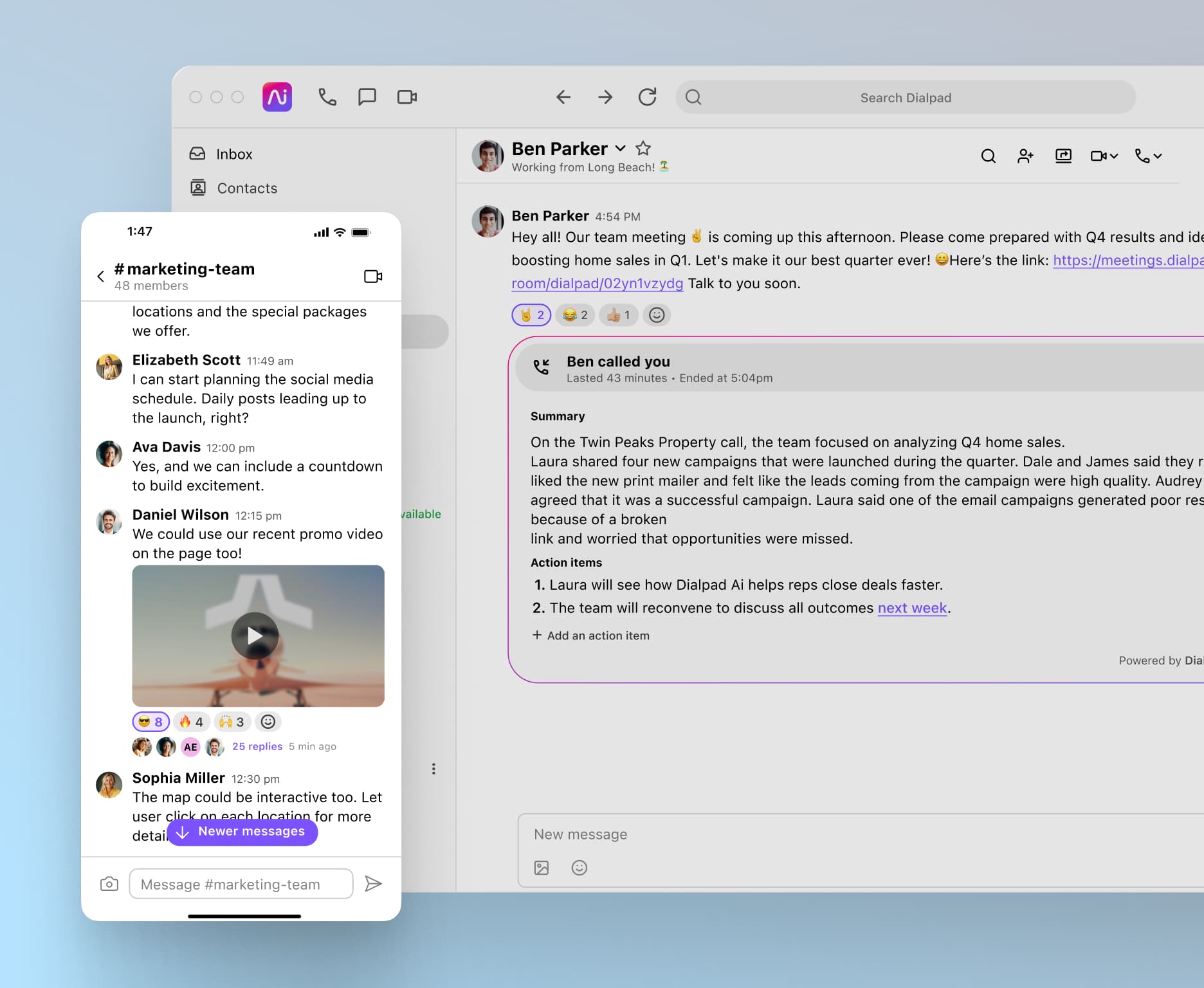
Okay. We might be biased, but hear us out.
Dialpad is a leading cloud communications platform that lets you talk, message, and meet with clients, teammates, and more—all from one unified app.
And because it's built on the Google Cloud Platform, Dialpad provides unparalleled flexibility, reliability, and scalability. Need to add a user or another VoIP phone number? You can do that in minutes, right in your online account:
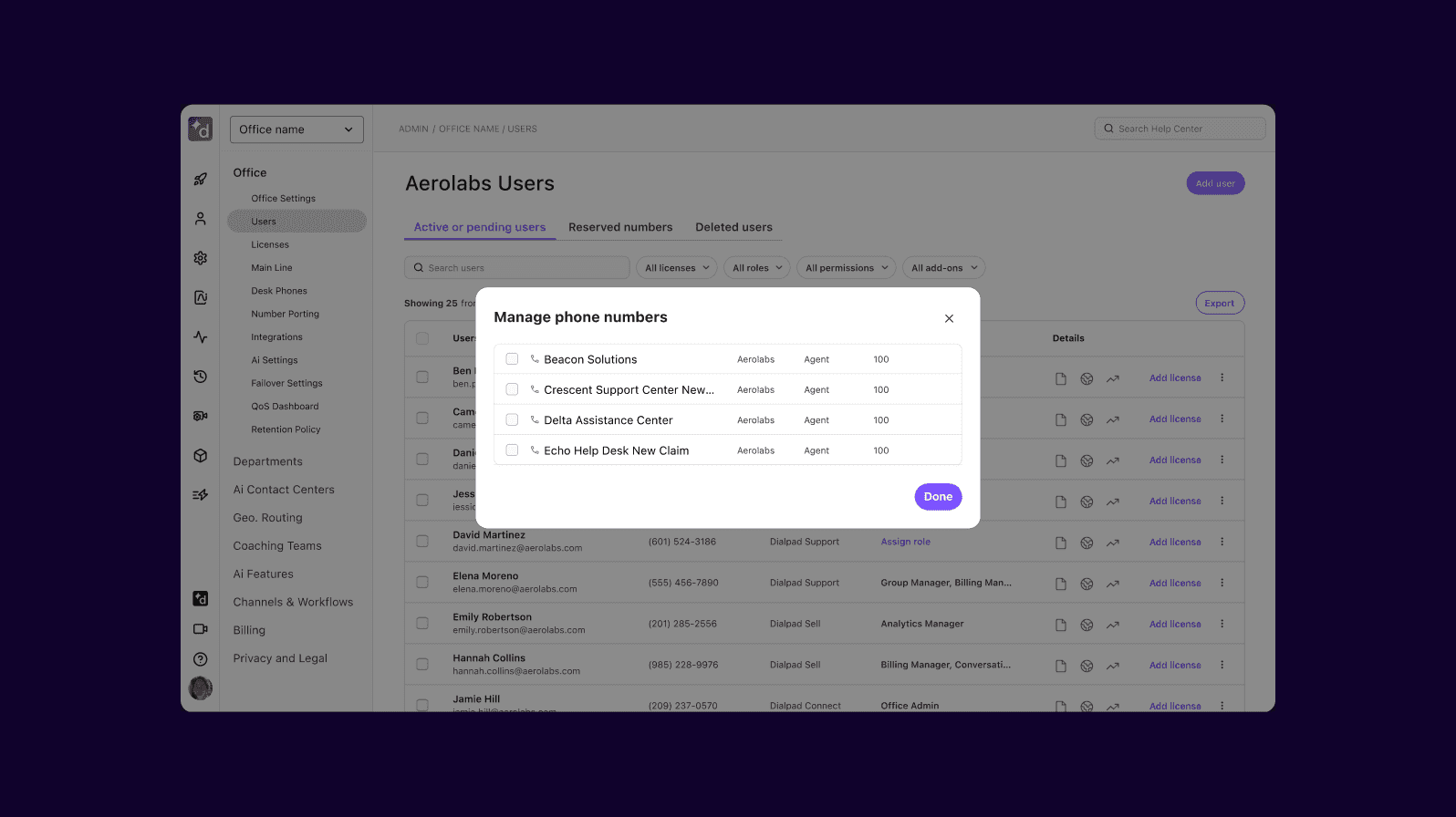
It's easy to use, easy to scale—and perfect for both small businesses and large enterprises.
Oh, and it also has fully integrated contact centre (or CCaaS) functionality. If you have a customer support or sales team, or just need to handle a high volume of communications with a certain group of people, that's built right into Dialpad's app.
Unlike many other UCaaS and CCaaS providers, this is all unified into one app and one user interface. You don't have to log into different accounts in different windows or have to get used to two different user experiences.
Basically, it goes far beyond a cloud phone system, and covers pretty much all of your business communications and customer experience needs.
The really unique thing about Dialpad as a UCaaS provider, however, is its proprietary AI technology. We call it Dialpad Ai, and it's built into all of our products. With built-in speech recognition and natural language processing, here’s just some of what it can do...
For starters, there’s real-time transcription. Dialpad Ai transcribes all your calls, meetings, and voicemails with industry-leading accuracy. You can see the running transcription for your call or meeting, right in your active call window:
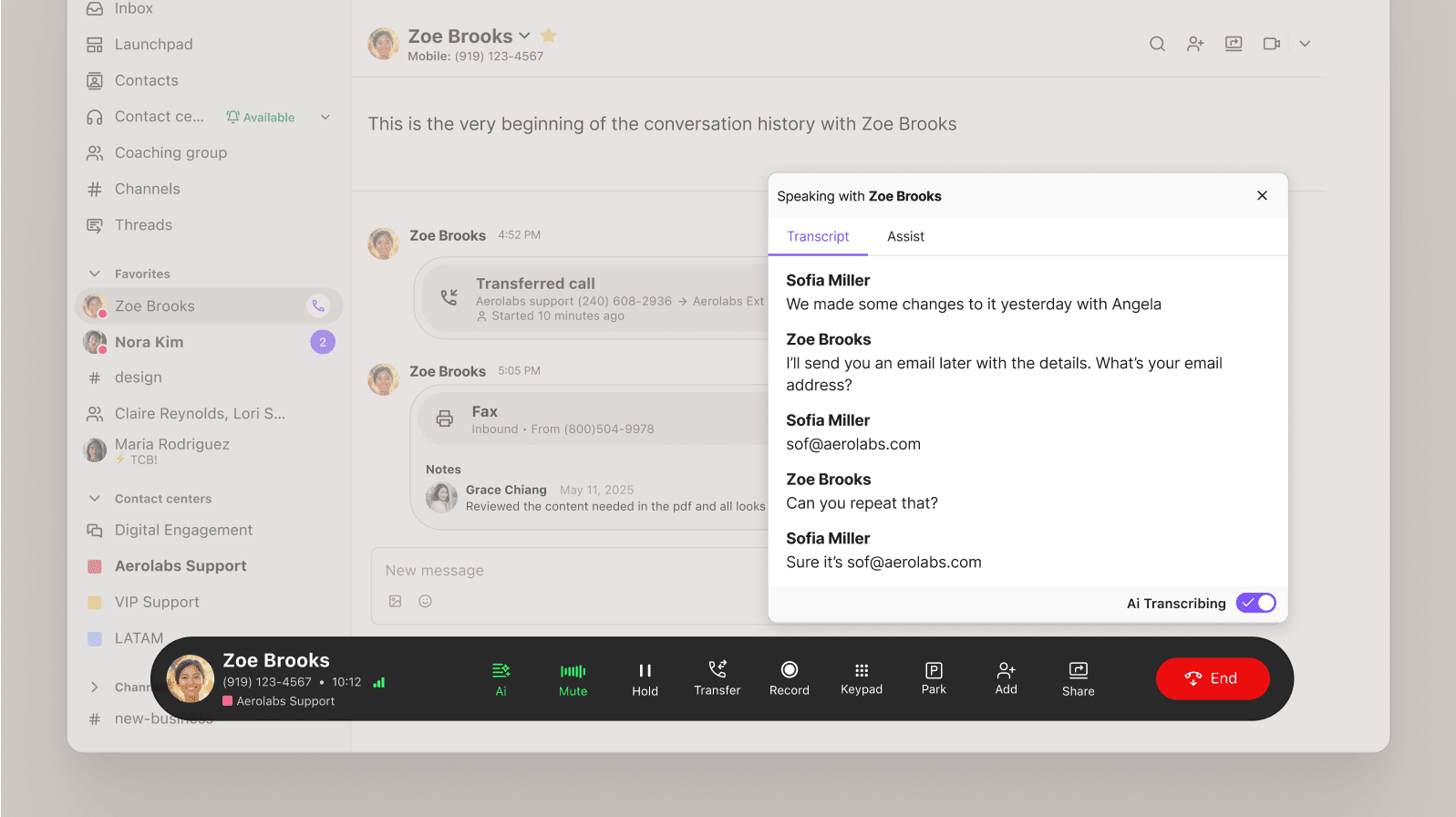
It can even detect action items because it can recognise voice commands (e.g. "I'll send you an email after this call"), meaning that you can stay on top of your memos—no note-taking needed.
Dialpad Ai also sends your call's attendees a convenient recap email after the meeting is over, with the searchable voice-to-text transcript, call centre transcripts, action terms, and recording, all compiled into an easily-digestible overview:
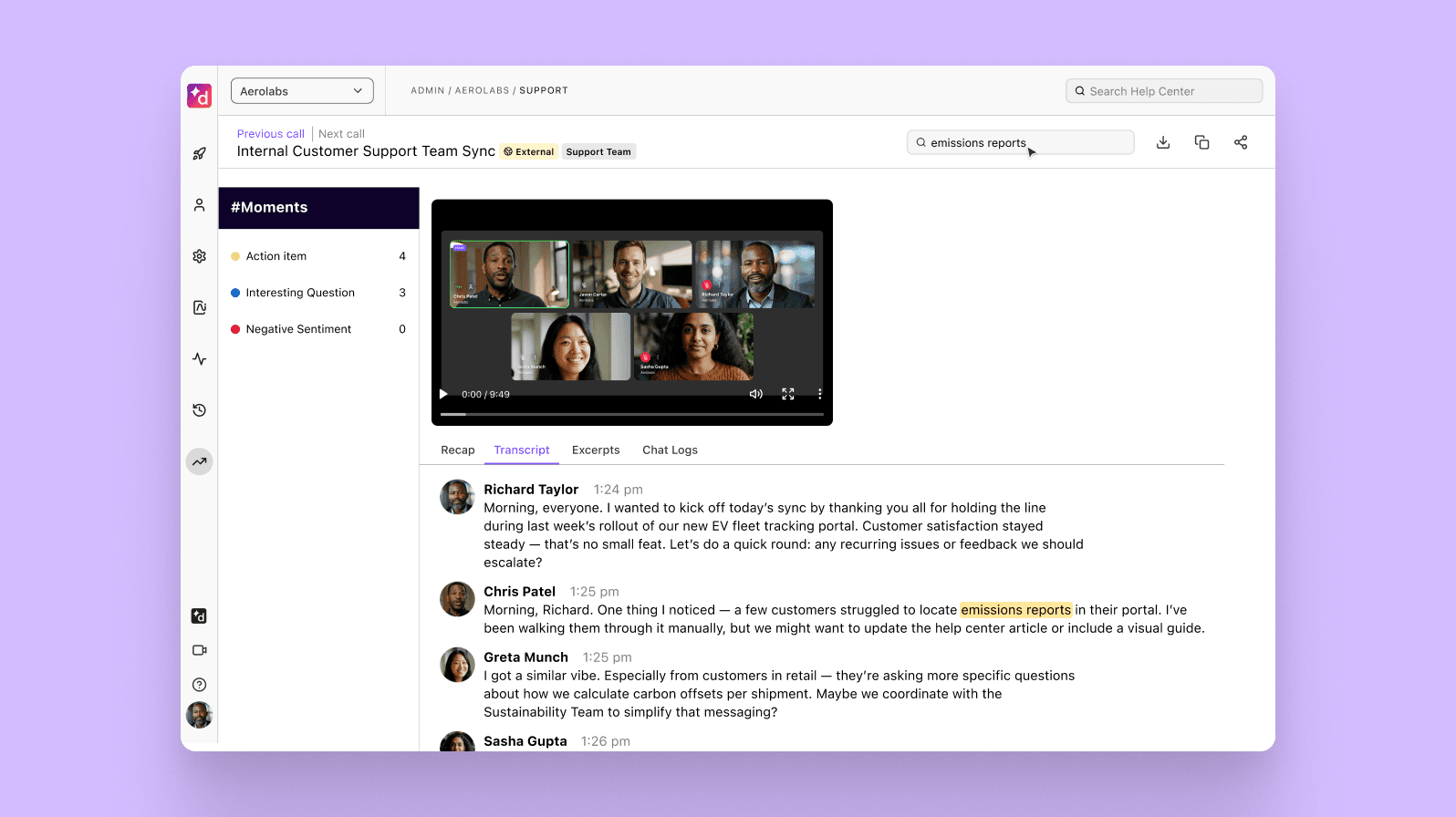
For contact centre teams, there are Real-Time Assist (RTA) cards and Ai Live Coach, designed to help agents through difficult conversations and significantly reduce training constraints.
With RTA cards, Dialpad’s advanced Ai is always standing by, ready to help. Whenever a customer mentions a certain keyword (like the name of a competitor, or whatever else you want to set up), it triggers the Ai to pop up helpful notes for the agent. And Ai Live Coach takes this a step further. Even if a supervisor hasn’t created an RTA card for a certain topic, Dialpad Ai can automatically scrape every connected knowledge base in real time to pop up useful resources for agents:
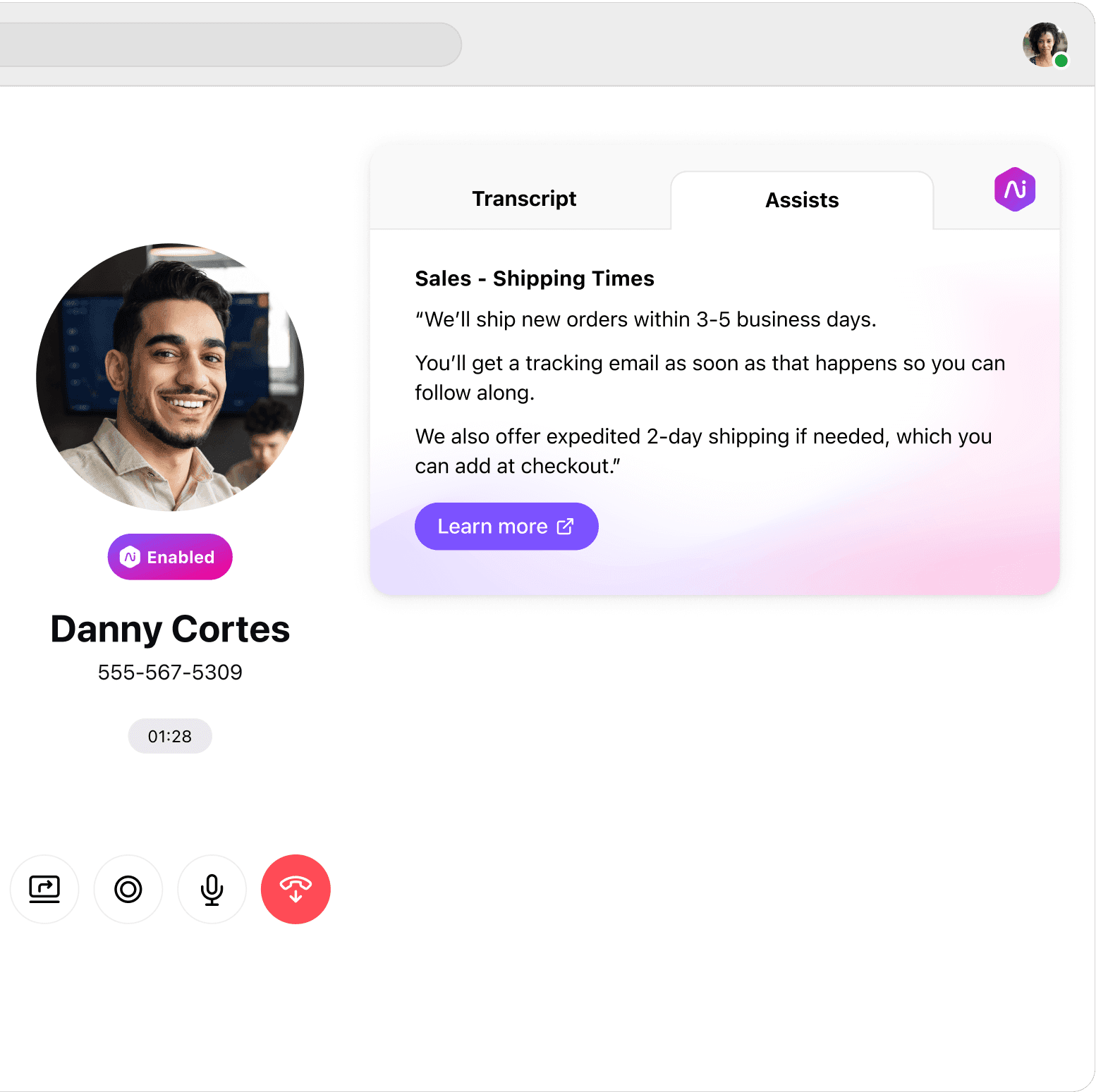
Want to know how your customers are feeling, even the ones who don’t fill out your CSAT survey—or even if you don’t have a CSAT survey? Ai CSAT automatically infers CSAT scores from every call, making it easy for every company to access meaningful customer insights:
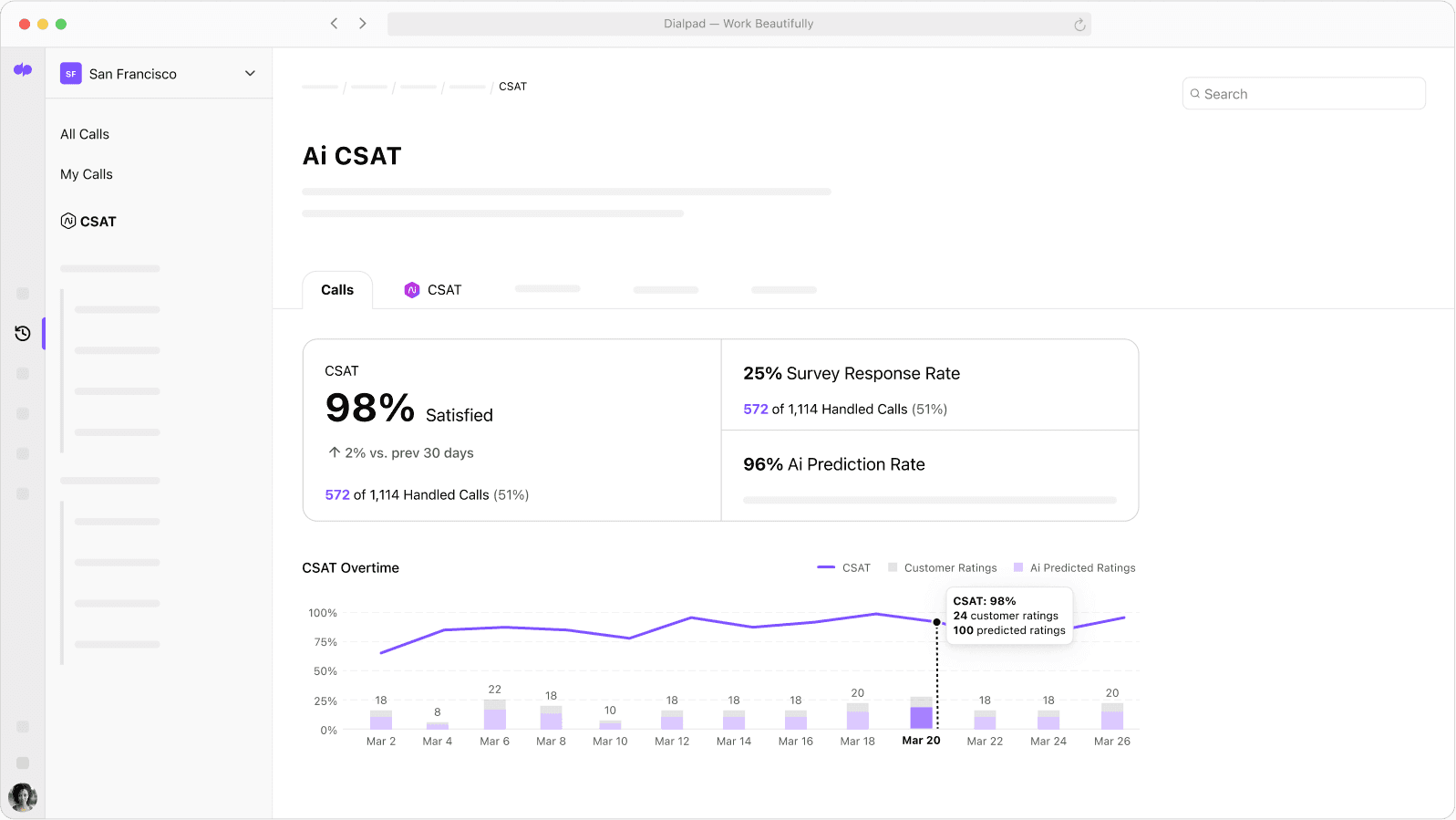
Best features
I can’t include all of Dialpad’s extensive list of features, so here are a few favourites in a quick rundown:
Fully unified communication solutions in one place, with a desktop and mobile application that lets you check notifications, handle all your communications, and work from anywhere
A global voice network and data centres that ensure high-quality calls, all around the world
Robust call management features including call recording, a call forwarding service, and more
Integrations with a range of business apps, CRMs, and more to enhance your team’s productivity and collaborative communication (like Salesforce, Zendesk, and Microsoft 365)
APIs so that you can build your own custom integrations if you want to
100% uptime SLA for Enterprise plan customers
A UCaaS provider that lets you manage all your communications in one place
Try it free with a 14-day trial, or book a personal walkthrough with our team!
2. 8x8
8x8 is a UCaaS platform that's been around for a long time—before cloud communications was really around. It has the usual bells and whistles: audio conferencing, video, SMS messaging, and an auto attendant.
It's not as modern a platform as some of the other options on this list, like Dialpad, but overall it's a popular and relatively reliable UCaaS provider with businesses (safe to say, since it's a public company), so it's second on the list.
🤿 Deep dive:
Get a detailed comparison of 8x8 vs Dialpad here.
3. Vonage
Vonage is another VoIP phone system that offers a range of basic unified communications features—and is also heavily focused on the residential phone service side of the business. (Learn more about how Vonage compares against Dialpad.)
It's one of the more expensive unified communications solutions on the market, and it doesn’t offer a free trial version. And if you want access to basic UCaaS features like video calls, conference calling, and text messaging, you’ll need to pay extra.1
🛒 Looking for a communications solution?
Our CIO put together a Buyer's Checklist for Business Communications Solutions! Get her tips and insights from years of buying software.
4. Zoom One
Initially just a video conferencing platform, Zoom has expanded its product to include voice calling and SMS text messaging.
That being said, it's much harder to build a telephony product than a video conferencing product, and compared to some of the other UCaaS providers on this list which started out with robust phone systems, Zoom is still catching up in some of these features (like call routing.)
Then there's the fact that it's prone to security issues and is a popular target for hackers and other unwanted guests (perhaps because of how popular it's been with a consumer audience). Even though pricing has always been a big reason why Zoom is popular, its UCaaS pricing is actually quite comparable to many of the options on this list.
5. Microsoft Teams
Microsoft Teams is a unified communication service that facilitates business communications through voice, video, and other collaboration tools.
Microsoft Teams is a popular option for businesses because of its name recognition, but it does have its limits. Like some of the UCaaS providers on the list that didn't start in telephony, this is a challenging part of the product to build out and takes time.
If phone calls are a big part of your business communications, this might be a limiting factor. (There's a reason why direct routing integrations—with many telephony-focused UCaaS solutions on this list!—are so heavily used with Microsoft Teams.)
🤿 Deep dive:
Get a detailed comparison of Dialpad vs Microsoft Teams here.
6. Cisco Webex
Webex (aka, Cisco Webex) is a UCaaS platform that offers collaboration features like video conferencing, chat, screen share, and meeting recordings.
It started as a video conferencing platform that was then bought by Cisco—and this is reflected in its pricing plans. It has a few tiers to choose from and at first glance looks like it comes with the usual functionality like video conferencing and messaging, but phone calls come at an added cost.2
If you need to make phone calls regularly for work, this isn't the best option.
7. RingCentral MVP
RingCentral MVP (previously known as RingCentral Office) is another unified communications platform that's been around since the PBX days.
RingCentral is also public, like 8x8, but as a Goliath in the space, its telephony and technology reflect it. (I won't go into too much detail—in the interest of not being too biased, try out a few free trials from the options here and read the customer reviews.)
Like Dialpad Ai Contact Centre, RingCentral has a call centre product—however, it's not RingCentral's own software and it's not fully integrated with its UCaaS product. (RingCentral is reselling another company's call centre software.) That means that if you need customer support, you'd likely be directed to a third party—and the user interface between UCaaS and CCaaS will be quite different.
🤿 Deep dive:
Get an in-depth breakdown of Dialpad vs RingCentral here.
8. GoTo Connect
GoTo Connect is a popular UCaaS solution that isn't quite as big as RingCentral and 8x8. It does have cloud telephony, SMS texting, video calling, a mobile app, and a few other features.
However, GoToConnect's pricing is on the high side.4 The lowest plan is almost double the cost of Dialpad's lowest plan, and not because it comes with more features either.
What does UCaaS look like in the future?
Modern UCaaS isn’t limited to just traditional functions like phone calls, chat, voicemail to email, and presence.
Some UCaaS systems are starting to expand to include contact centre functionality, which means that not only office workers can stay connected internally as well as externally with customers from a single unified platform—this includes contact centre agents and supervisors, too.
Good UCaaS platforms also integrate with an extensive range of business software and apps. This is a trend that's already quite obvious, but it should continue to grow even more in the future. With so many tools out there, integrations are essential for streamlining workflows.
(Just look at consumers, who are reaching out to businesses over not just phone calls now, but also email, live chat, social media, and more.)
Enable business communications with the top UCaaS providers in the industry
If you're looking for a communications system for your business, the good news is you're spoiled for choice. But even though there are plenty of great options to pick from, choosing a solution that offers a range of advanced features and provides the flexibility, mobility, and scalability you need to grow your business is a little tougher.
Be sure to select a UCaaS system that’ll continue to serve you well in the future, too. This means looking into how service providers use technologies like artificial intelligence and machine learning to further enhance business communications and collaboration.
After all, your business phone system should be able to scale up (or down!) with your business.
Looking for a UCaaS provider that is easy to use and scalable?
And that can handle all your internal and external communications? Take Dialpad for a test drive with a 14-day free trial or, take a self-guided interactive tour of the app!
1vonage.com/unified-communications/pricing/?bypassgeoloc=true
2webex.com/pricing/index.html
3contact-centres.com/ringcentral-and-nice-expand-and-extend-contact-centre-partnership/
4goto.com/pricing/connect
